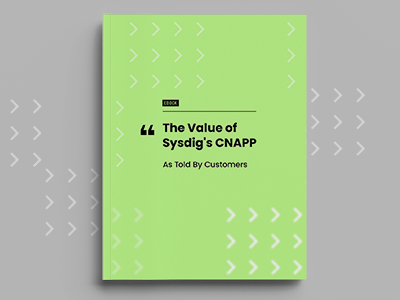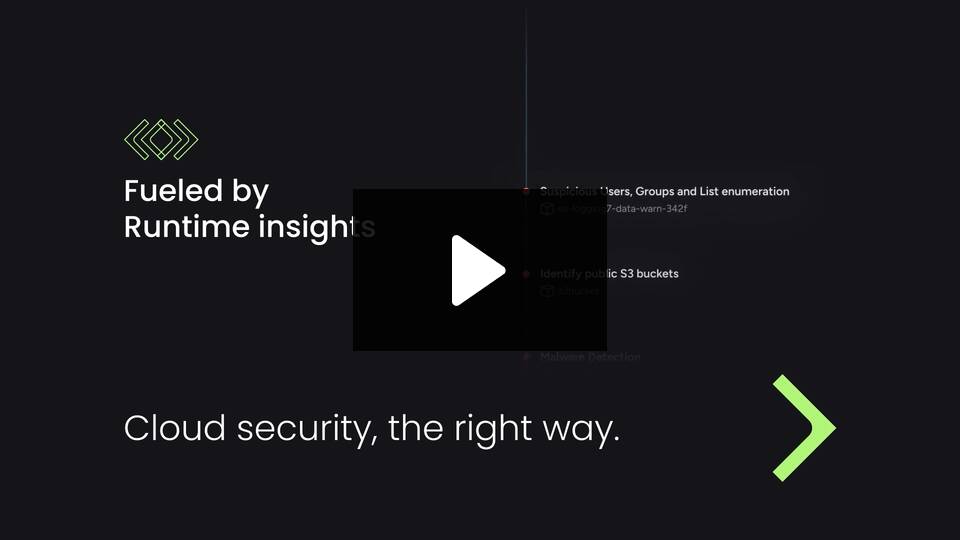What is CNAPP?
Organizations used to struggle with cloud security due to siloed tools that didn’t communicate well with each other. With threat actors targeting cloud environments more and more, the security industry needed a comprehensive platform, which led to the development of cloud-native application protection platforms.
CNAPP definition
A cloud-native application protection platform (CNAPP) is an integrated cloud security solution that helps organizations secure applications and infrastructure across the entire application lifecycle. CNAPPs combine the capabilities of cloud security posture management (CSPM), cloud workload protection platform (CWPP), cloud infrastructure entitlement management (CIEM), and others into a unified platform. It enables end-to-end visibility, risk prioritization, vulnerability management, and threat detection for modern cloud-native environments.
As organizations increase their adoption of microservices, containers, Kubernetes, and multi-cloud strategies, traditional security tools struggle to keep up with the complexity and scale of cloud-native infrastructure. CNAPPs were built to close these gaps, bringing context, automation, and reliability to cloud security across development and runtime.
As cloud-native architecture evolves, attackers are also leveraging automation and adversarial artificial intelligence (AI) to move faster. CNAPPs are now starting to incorporate AI-driven security insights, which help teams keep pace by detecting risk earlier and responding more effectively.
Why CNAPP is important
Before CNAPP entered the cybersecurity market, businesses faced a rocky path when it came to securing their cloud operations due to limited and fragmented security resources. Organizations relied on tools like firewalls, virtual private networks, and intrusion detection systems that weren’t designed for the dynamic and distributed nature of cloud environments.
As workloads moved to cloud-native infrastructure, these traditional security tools struggled to provide visibility or unified protection. Cloud operations security (focused on securing workloads and infrastructure) and application development security (focused on securing code and pipelines) were managed separately, often by different teams with different tools. This created blind spots and inconsistent enforcement of policies.
The growing number of cybercriminals targeting cloud-based infrastructure led to a shift to a shared responsibility model between cloud service providers (CSPs) and customers, and organizations were given greater responsibility to safeguard their own cloud infrastructure. This siloed model was clearly unsustainable and led to a whirlwind of innovation in cloud security technologies, which eventually led to CNAPP solutions. These platforms were designed to consolidate cloud security into a single, cohesive solution, bridging the gap between dev, security, and ops teams.
What problems does CNAPP solve?
CNAPP solutions simplify cloud security in meaningful ways that are easy for everyone to understand. Let’s break down the problems they solve:
- Tool sprawl
With CNAPP solutions, organizations can say goodbye to the headache of juggling multiple technologies. By offering a single, unified platform, CNAPPs consolidate CSPM, CIEM, identity and access management (IAM), CWPP, data protection, and more in one platform. This means no more scrambling to manage a bunch of different tools. CNAPPs streamline and simplify everything for you. - Lack of end-to-end protection
CNAPP solutions provide rock-solid security to keep your sensitive cloud-stored data safe from prying eyes. How? By beefing up your defenses with robust access controls, encryption, and vigilant monitoring. With a CNAPP, you can breathe easy knowing your data is shielded from unauthorized access and potential breaches. - Compliance challenges
CNAPP solutions make meeting regulatory compliance a breeze by providing tools for continuous monitoring, auditing, and reporting on cloud security controls. - Visibility gaps
To overcome the blind spots in cloud environments, CNAPP solutions step in with robust monitoring and logging features. This enables organizations to get a clear view of network traffic, user activities, and potential security threats. - Developer responsibility in cloud security
CNAPP solutions play a vital role in supporting engineers throughout the development lifecycle with early error detection and comprehensive runtime visibility. By integrating a CNAPP into your workflow, your developers gain the tools they need to proactively address security concerns, ensuring the resilience and reliability of their cloud-native environments.
Benefits of CNAPP
Beyond addressing legacy cloud security challenges, a CNAPP solution offers a range of crucial advantages. Let’s explore how CNAPPs transform cloud security, empowering teams to reach their objectives:
- Increased efficiency
CNAPPs simplify security operations by replacing multiple point products and providing a unified view of risk. This streamlines the process, freeing teams from the burden of mastering various tools and managing alerts from different sources. By consolidating security functions into a single platform, CNAPPs enable teams to streamline their workflows, boosting productivity and efficiency. - Comprehensive visibility
CNAPPs provide a unified view for your teams to swiftly pinpoint issues, events, and potential attack paths. Through user-friendly visual layouts, alerts, suggestions, and guidance for remedial actions, you can make informed decisions and proactively safeguard against threats. - Enhanced cloud security
CNAPPs offer an end-to-end solution, ensuring consistent threat detection and visibility across any workload, cloud, or service. By leveraging techniques such as machine learning and threat feeds, CNAPPs enable organizations to effectively identify and respond to threats, reducing the attack surface in cloud-native environments. - Multi-cloud security coverage
CNAPP strengthens multi-cloud security as it gives you a clear view of all your resources across different clouds, like where you’re storing things (infrastructure as a service) and what platforms you’re using (platforms as a service). They check out everything from virtual machines to containers and even your dev setups. This helps catch and fix problems early, making sure your security covers everything. - Shift left
Through seamless integration with current development and DevOps tools, CNAPPs improve the software development lifecycle. By embracing both “shift left” and “shield right” security principles, CNAPPs offer a robust and comprehensive security strategy across the application lifecycle. This approach enables early detection and swift response to security incidents.
How CNAPP works
CNAPPs make cloud security simple by bringing together visibility into runtime risks, cloud risks, and development artifacts all in one place. CNAPPs work by ingesting data from your cloud environments to identify risks like misconfigurations, vulnerabilities, access control issues, and runtime security threats. By shining a light on all corners of your cloud, security teams can discover, understand, and fix risks. CNAPPs provide risk prioritization so teams know what to remediate first without getting bogged down by the staggering number of risks.
To achieve this, CNAPPs typically use two different methods: agent-based and agentless.

- Agent-based approaches stay close to the workloads:
They require an agent (often called sensor or probe) executing alongside the workloads on the instrumented machine. Being on the same host grants real-time visibility into runtime assets and allows access to system-level context information, something that is not available otherwise.
- Agentless approaches use cloud provider APIs:
It gathers relevant context without needing an agent running along the workloads. These solutions often take snapshots to defer the security scans on a point-in-time copy, leaving the original workload unaltered. While this approach lacks the deep runtime insights that an agent provides, it offers a frictionless solution for tackling issues that do not need to rely on real-time data, like building an asset inventory, or identifying known vulnerabilities and anomalous behavior in audit logs.
For a strong CNAPP solution, it’s important to use both agent-based and agentless approaches to get the best results. Agent-based methods help you see what’s happening in real time and give you lots of detail about how your system works. On the other hand, agentless approaches are great for finding known vulnerabilities and spotting anomalous activity in your logs.
How to choose a CNAPP
Now that we’ve explored the benefits that CNAPPs offer and their inner workings, it’s time to delve into the process of selecting the right one for your organization. What factors should you consider when planning to adopt a solution? Here are the key components and capabilities that a CNAPP should offer to empower your organization’s security posture.
Key CNAPP components
An effective CNAPP consolidates multiple cloud security solutions into one comprehensive option. Most CNAPPs feature the following cloud security tools:
- Cloud security posture management (CSPM)
CSPM allows you to monitor, identify, alert on, and remediate compliance risks and misconfigurations within your cloud environments. It’s your watchdog for ensuring your cloud infrastructure remains compliant and secure. - Cloud detection and response (CDR)
CDR plays a vital role in a CNAPP by providing advanced threat detection, incident response, and continuous monitoring capabilities specifically designed for cloud environments. CDR within a CNAPP leverages cloud-native security controls to gain real-time visibility into cloud assets, configurations, and activities. - Cloud infrastructure entitlement management (CIEM)
CIEM is your shield against data breaches in public clouds. By continuously monitoring permissions and activities, it helps mitigate the risk of unauthorized access to sensitive data. - Data protection
Safeguarding your critical data is paramount. With data protection capabilities, a CNAPP can monitor, classify, and inspect data to prevent its exfiltration due to phishing attempts, insider threats, or other cyber threats. - Identity and access management (IAM)
IAM ensures that the right people have the right access to your organization’s resources. By controlling access to internal systems and data, IAM helps prevent unauthorized access and data breaches. - Cloud workload protection platforms (CWPP)
CWPPs offer visibility and control over various workloads, including physical machines, virtual machines, containers, and serverless environments. It’s your comprehensive solution for securing workloads across hybrid, multi-cloud, and data center environments.
Key capabilities of CNAPP
When it comes to figuring out the key capabilities of CNAPPs, Gartner’s Market Guide for CNAPPs is a handy resource. Here’s a breakdown of Gartner’s suggested capabilities:
Core CNAPP capabilities
- CSPM, including integration with leading hyperscaler providers.
- Kubernetes security posture management, which provides security risk analysis of Kubernetes orchestration platforms.
- Infrastructure as code (IaC) scanning, including for major IaC scripting languages and YAML or Helm for Kubernetes.
- Ability to understand and control identity, roles, permissions, and entitlements in cloud environments to provide better context for building risk-prioritized attack graphs.
- Scanning containers and container registries for risks.
- Cloud workload protection providing agentless runtime visibility, point-in-time analysis of workloads, and attack path analysis.
Recommended CNAPP capabilities
- Advanced cloud workload protection providing agent-based runtime visibility and real-time runtime analysis of workloads.
- API discovery and monitoring.
- Scanning of unstructured IaaS data repositories for risk.
- Traffic monitoring capabilities and connectivity mapping.
- CDR capabilities beyond just workload monitoring, such as looking at event logs, network logs, and DNS look-ups.
- Workload drift detection from expected state.
- Support for other common clouds like Oracle Cloud, IBM Cloud, or Alibaba Cloud.
- Scanning of other application artifacts for risk.
- Serverless code scanning.
- Software composition analysis, including software bill of materials (SBOM) creation.
- Application layer observability.
- Scanning of code repositories.
- Support for eBPF.
Questions to ask CNAPP vendors
As you start looking for a CNAPP solution, it’s important to get a good understanding of what each vendor offers. Here are some questions you can ask to help you figure out which CNAPP solution is right for your organization:
- Does your CNAPP include consolidated components such as CSPM, CIEM, CWPP, IAM, and data protection?
- Can your CNAPP apply runtime insights to provide a prioritized and contextual view of risk?
- How does your CNAPP provide unified security and risk dashboards across cloud, containers, and Kubernetes environments?
- Does your CNAPP support both an agentless and agent-based approach?
- Is your CNAPP an enterprise-grade platform that integrates and aligns with API use, scripting, and automation functionality?
- What is the vendor onboarding process like, and what level of ongoing support do you provide?
AI and the future of CNAPP
As cloud-native environments become more dynamic and data volumes surge, CNAPPs must scale with the complexity. This explosion of signals, both high- and low-fidelity, can overwhelm security teams and create noise that obscures true risk.
To meet this challenge, the next generation of CNAPP platforms is increasingly incorporating AI to accelerate detection and response, prioritize risk with greater precision, and support guided remediation to make cloud security more accessible across teams.
As attackers turn to automation and AI to scale their efforts, security teams will increasingly rely on AI-powered CNAPPs to reduce response time, improve signal-to-noise ratio, and drive smarter, more proactive cloud defense strategies. While still in the early stages, these capabilities are quickly becoming foundational in helping organizations secure fast-moving cloud-native environments.
%201.svg)




